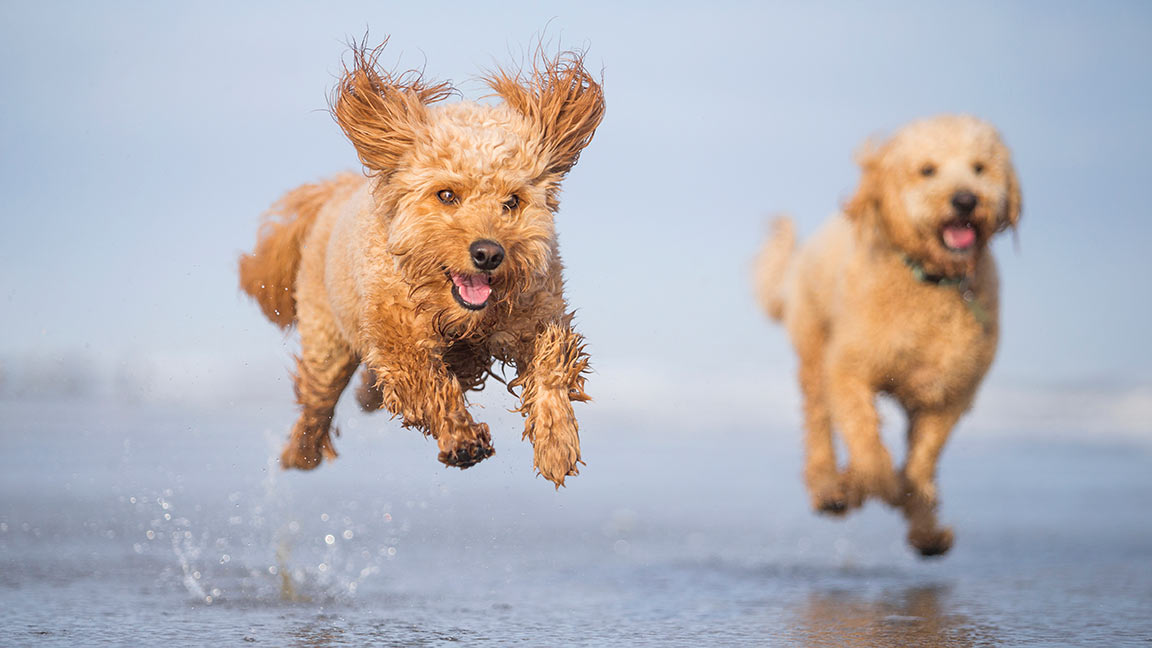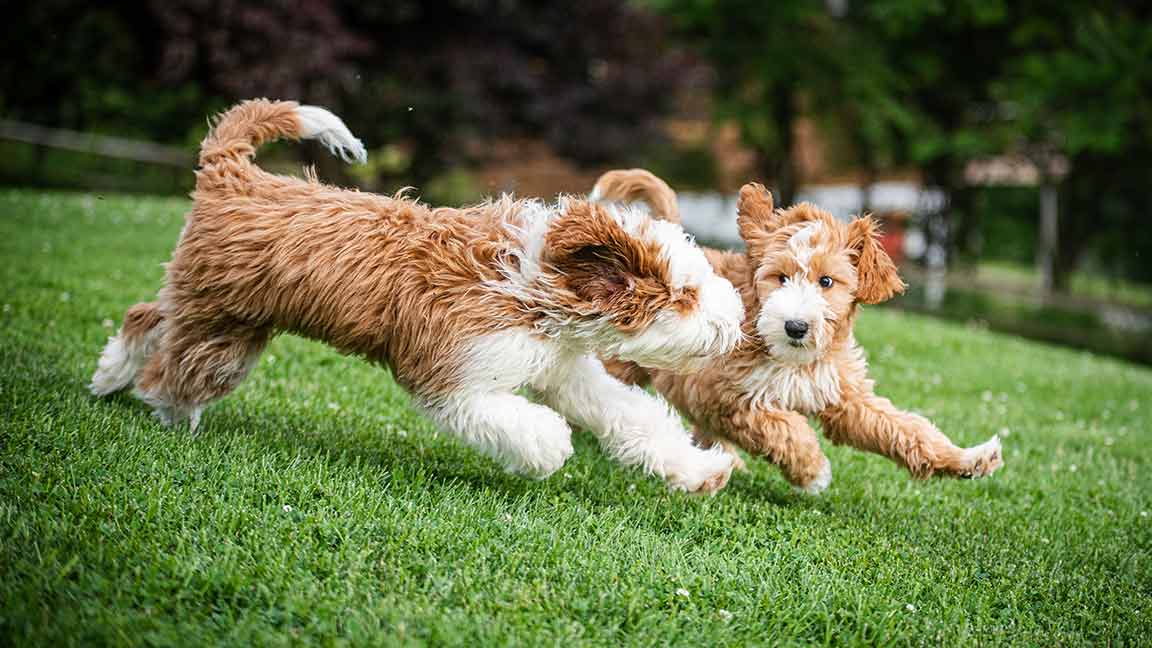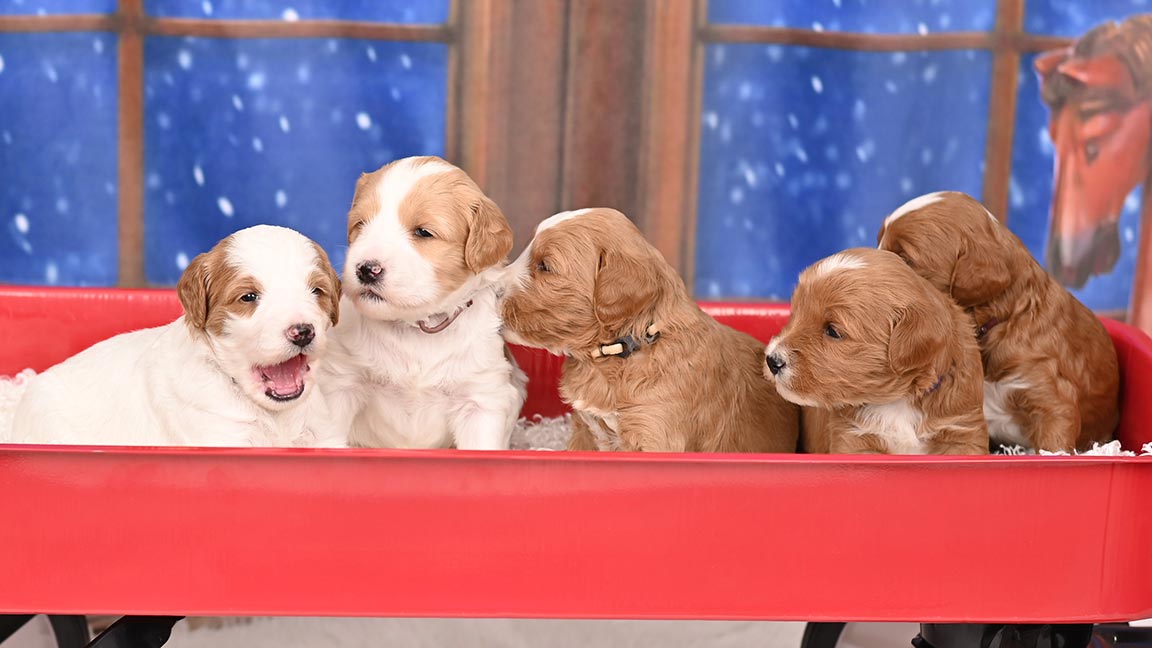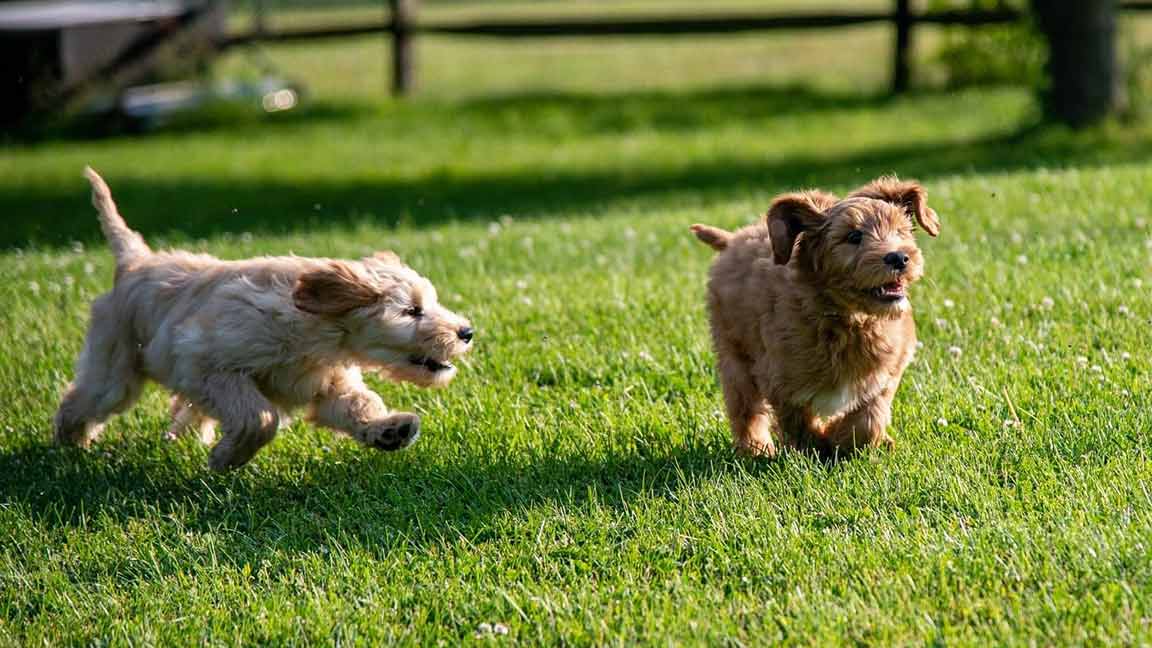
17 Tips to Keep Your Dog Cool in the Summer Heat
Summer days are here again! But with these bright, sunny days come the risks associated with high temperatures and heat waves. These warmer conditions can make your Goldendoodle or any dog susceptible to heat-related illnesses, including heat stroke and exhaustion. So, how do you keep your Goldendoodle cool and ensure their safety during the summer months?
Here are 17 tips to keep your dog cool in the summer heat. These guidelines help stabilize your doggy’s core body temperature and prevent heat-related health conditions. Even though this guide frequently refers to Goldendoodles, the tips apply to all dogs.
1. Provide Plenty of Water for Your Dog
The most crucial step to keeping your dog cool in the summer heat is providing plenty of water. Dogs need to stay hydrated to maintain a healthy body temperature. Make sure your dog always has access to fresh, cool water. Automatic water bowls can be handy, especially if you’re out most of the day. Dehydration in your furry friends can lead to serious health problems. It can make them more vulnerable to heat-related illnesses such as heat stroke and exhaustion. Therefore, ensuring your dog has access to plenty of water during summer is critical to keeping them cool and healthy. If you want to entice your dog to drink more water to prepare for being outdoors, you can add bone broth to their water. This not only helps to increase their water intake but also has many other health benefits.
Understanding Dehydration in Dogs
Like humans, a dog’s body is mainly composed of water – roughly 80%. Water helps maintain a healthy metabolism, lubricates joints, aids digestion, and regulates body temperature. When a dog’s body loses more fluids than it consumes, dehydration occurs.
Dogs experiencing dehydration may show reduced skin elasticity, laziness, heavy breathing, sunken eyes, dry nose, and parched gums. In severe cases, it can lead to organ failure and even death.
How Much Water Does Your Dog Need?
The amount of water a dog needs can depend on various factors such as size, age, and activity level. Drinking at least one ounce of water per pound of body weight every day is crucial for maintaining good health. This amount increases if the dog is active or if the weather is hot.
2. Use a Cooling Mat
In our quest to keep our furry friends comfortable during the summer heat, one tool that can be incredibly beneficial is a cooling mat. But what are cooling mats, and how do they work?
Choosing the Right Cooling Mat for Your Dog
When choosing a cooling mat, it’s essential to consider the size of your dog and the location you intend to use the mat. It’s important to note that certain cooling mats are designed specifically for indoor use. In contrast, others are better suited for outdoor settings. Similarly, you’ll want to choose a durable mat that can withstand your dog’s weight and activity level.
Safety Considerations
While cooling mats are generally safe, it’s essential to supervise your dog when using the mat, especially in the beginning. Ensure they are not trying to chew or eat the mat, as this could lead to potential choking hazards or ingestion of harmful materials.
 3. Provide Shade
3. Provide Shade
If your dog enjoys being outside, ensure there’s a shaded area where they can retreat from the sun. You can use a tree, an umbrella, or even a specially designed-pet shade.
Shade is essential in keeping your Goldendoodle or any dog cool during the scorching summer months. Direct sunlight and high temperatures can quickly increase a dog’s core body temperature putting them at risk of overheating, heat stroke, or heat exhaustion.
The Importance of Shade for Dogs
Dogs, like humans, can get sunburned, especially those with short or light-colored coats. Overexposure to the sun can also lead to skin damage and increase the risk of skin cancer.
Dogs need a cool environment to bring down their body temperature. This is because dogs primarily cool down through panting and, to a lesser extent, through their paw pads. Unlike humans, dogs can’t sweat through their skin to cool off, making it even more challenging to cool down in hot conditions.
4. Avoid Peak Sun Hours
Avoid taking your dog out during peak sun hours, typically between 10 a.m. and 4 p.m. The temperature can be excessively high during these hours, increasing the risk of overheating.
The sun is strongest in the summer between 10 a.m. and 4 p.m. This is when the day reaches its highest temperatures, with UV rays most intense. Therefore, it’s a hazardous time for your dog to be outdoors for prolonged periods.
Heat Stroke and Other Risks
Like humans, dogs can experience heat stroke. This heat-related illness happens when their body temperature increases beyond the usual range. If left untreated, heat stroke can be fatal. Although all dogs are prone to heat stroke, breeds with double coats, such as Goldendoodles, are more vulnerable.
Symptoms of heat stroke include heavy panting, excessive drooling, difficulty breathing, and even collapse. It can lead to seizures, organ failure, and death in severe cases.
In addition to heat stroke, the risk of overheating and dehydration increases during peak sun hours. This can result in many health issues, including kidney disease, heart problems, and skin conditions.
5. Limit Exercise
Limit your dog’s exercise on hot days. Heat exhaustion can quickly occur if your dog is overly active in high temperatures. Instead, opt for early morning or late evening walks when it’s cooler.
Adjusting Your Dog’s Exercise Routine
Adjust your dog’s exercise routine during the summer to avoid the hottest parts of the day. During these peak hours, the heat can be intense and potentially harmful to your dog. Instead, opt for early or late evening walks when temperatures are lower. The cooler air will make the exercise more comfortable and less risky for your dog. Furthermore, the pavement will be cooler, reducing the risk of your dog burning its paws on hot asphalt or concrete.
6. Never Leave Your Dog in a Car
To ensure the safety and well-being of your furry friend, it is imperative to refrain from leaving them unattended in a vehicle during the warmer months of the year. The temperature inside a vehicle can rapidly rise, causing heat stroke within minutes. Leaving the windows cracked open in a car is not enough to prevent it from becoming extremely hot.
Understanding the Danger
On a warm day, the temperature inside a car can rapidly increase to dangerous levels in just a few minutes. Even on a relatively mild day, with an outside temperature of 70°F (21°C), the temperature inside a car can rise to 89°F (32°C) within just 10 minutes. After 30 minutes, the temperature can reach 104°F (40°C). And remember, this is on a 70°F day – imagine the intensity on a day when the outside temperature is 85°F or 90°F.
7. Regular Grooming
Regular grooming can help to keep your Goldendoodle cool. Their double coats can become heavy and hot if not adequately cared for. However, never shave a double-coated dog as their fur provides protection from the sun and helps regulate body temperature.
Understanding Your Dog’s Double Coat
Many dogs, including Goldendoodles, have what’s known as a double coat. This is a dense undercoat beneath a top layer of longer guard hairs. This double layer serves several purposes. In the winter, it traps heat to keep the dog warm. However, in the summer, it provides insulation against the heat and protects against sunburn.
Despite what you might think, shaving a double-coated dog makes them hotter. It removes the insulating layer of fur, exposing the skin to the sun’s rays. Know your Goldendoodle generations and fur type.
 8. Use a Kiddie Pool
8. Use a Kiddie Pool
Giving your dog a kiddie pool filled with cool water can be a fun and refreshing way for them to cool down. However, it’s essential always to supervise your dog while they are in the water.
Why a Kiddie Pool?
Water is a superb conductor of heat, allowing it to draw the excess heat from your dog’s body more efficiently than air. While a cooling mat can help somewhat, water can lower your dog’s body temperature more rapidly. That’s where a kiddie pool comes into play.
Moreover, many dogs naturally enjoy the water. The pool not only provides a way to escape the heat, but it also offers a fun activity that can keep your dog entertained. Check the water temperature often if the pool is exposed to direct sun, as the water can become hot and may need to be changed.
9. Use Cooling Vests or Bandanas
Cooling vests or bandanas for dogs are a great way to keep your pup cool on hot days. Made from lightweight fabrics such as cotton and polyester, these garments are designed to help regulate the dog’s body temperature by drawing heat away from their core.
How Do They Work?
Cooling vests and bandanas work on the principle of evaporation. They’re typically made of a unique fabric that can retain water when soaked. The retained water slowly evaporates, removing heat from your dog’s body. This evaporation process mimics the way humans sweat to cool down, something that dogs can’t do effectively.
10. Try Frozen Treats
Giving your dog frozen treats is an excellent way to keep them cool and happy during hot summer days. A great option is to make your frozen treats at home. This can be a fun and easy process. Not only will your dog find these treats tasty, but they are also healthier than store-bought options. For a tasty and refreshing treat, try freezing chunks of fruits like watermelon (seedless) or apple-in-bone broth. You can also mix one tablespoon of bone broth with one cup of water and freeze it in an ice tray. Other homemade frozen treat options include freezing peanut butter or yogurt. There are several other dog-friendly options you can consider as well. For instance, dog-friendly ice cream is now available in many pet stores. Remember, regular ice cream may contain harmful ingredients, so always opt for products made specifically for dogs.
Remember, any treat, even frozen, should be given in moderation to maintain a balanced diet.
11. Protect Their Paws
Hot pavement can burn your dog’s paws. If the ground is too hot for your hand, it’s too hot for your dog’s paws. Consider protective booties or only walking in grassy areas.
To protect your dog’s sensitive paws, consider investing in dog booties. These protective shoes shield your dog’s paws from the hot pavement. They come in various sizes to suit different breeds and paw sizes.
If your dog isn’t comfortable wearing booties, you can opt for dog-friendly paw wax. This wax creates a protective barrier between your dog’s paws and the hot pavement. This product can be applied and removed quickly and is safe for dogs, even if they lick it off.
Consider taking your dog for a walk in areas with grass or shade to keep its paws on a cooler surface. A great remedy for cracked and dry pads is a healing balm.
12. Keep Your Dog’s Indoor Environment Cool
If you’re out during the day, ensure your dog’s indoor environment is cool. This may mean leaving the air conditioner on or having fans circulate cool air.
If you have air conditioning, consider leaving it in a moderate setting when you’re not home. This can help maintain a cool temperature indoors and provide peace for your dog. If you’re concerned about energy usage, programmable thermostats allow you to schedule times for the air conditioning to turn on and off.
If you don’t have air conditioning, you can use fans to move the air around and create a cooler sensation. Place fans in areas where your dog likes to rest. Ensure the fan is placed somewhere other than where your dog can knock it over.
Closing curtains and blinds is another excellent way to cool down your home. This can help block out sunlight and keep indoor temperatures down.
13. Provide Wet Towels
Laying wet towels for your dog to lie on can be a quick and affordable way to help them cool down.
A wet towel can act as a makeshift cooling mat for your dog. Dampen a towel with cold water and place it on the floor for your dog to lie upon. This method is not only cost-effective but is also portable. You can quickly move the towel to different locations, both indoors and outdoors.
14. Encourage Rest
Encourage your dog to rest and relax instead of running and playing during the hottest parts of the day. Resting reduces the risk of heat exhaustion.
During hot summer days, encourage your dog to take it easy. Physical exertion increases the body’s metabolic heat production, raising the core body temperature. Dogs, especially those with thick fur like Goldendoodles, are more susceptible to overheating during periods of activity in hot weather. By encouraging rest and relaxation during the day’s hottest hours, you reduce the risk of heat exhaustion and other heat-related illnesses.
15. Monitor for Signs of Heat Stroke
Monitor your dog closely for signs of heat stroke, such as heavy panting, drooling, red or pale gums, lethargy, and rapid heart rate. If you notice any of these signs, cool your pet down as quickly as possible and consult a vet.
Heat stroke is a serious condition that can be fatal if not addressed promptly. It’s vital that you are aware of the signs of heat stroke in dogs. More severe signs include vomiting, diarrhea, seizures, and loss of consciousness.
If your dog displays any of these symptoms, take action immediately to cool them down. Move them to a cooler environment, offer cool (not cold) water to drink, and dampen their body with cool water. Most importantly, contact a vet as soon as possible for further advice.
16. Regular Vet Check-ups
Regular vet check-ups can ensure your dog is healthy and well-prepared for the summer heat. Some health conditions can make dogs more prone to heat-related illnesses, and routine vet visits can help identify these potential risks. Your vet can also provide personalized advice on how to keep your specific dog breed cool during summer.
17. Educate Yourself
And finally, educate yourself about the signs of heat-related illnesses, how to prevent them, and what to do if your dog shows signs of distress. The more you know, the better prepared you’ll be to keep your Goldendoodle or any other dog cool in the summer.
By implementing these tips, you can ensure that your dog will stay cool and comfortable during the summer heat. So go ahead, and embrace the warmth of the summer days, but always remember to prioritize your dog’s safety. With these tips, you can prevent heat stroke, heat exhaustion, and other forms of heat-related illness, ensuring that your Goldendoodle stays cool and enjoys the summer months just as much as you do.
Caring for your Goldendoodle in the summer heat can feel like a challenge, staying mindful of their heat tolerance level is crucial to have a safe and happy summer.
Interested in learning more about Goldendoodles, check out our blog for more information like this.
Fox Creek Farm breeds a select number of Goldendoodle puppies each year, check for puppy availability and get on the waiting list to get a puppy from our internationally respected lineage of teddybear-looking Goldendoodles.





